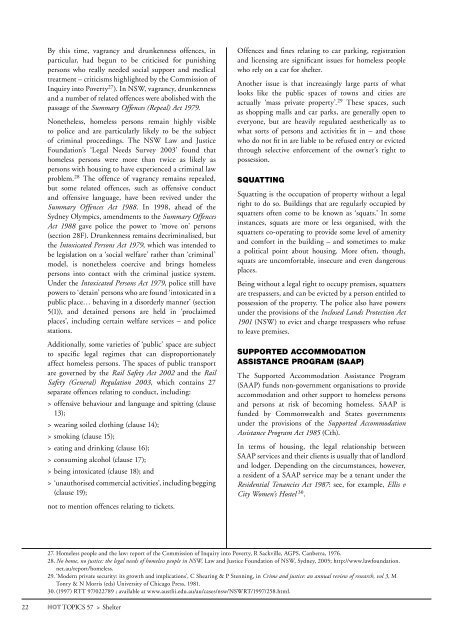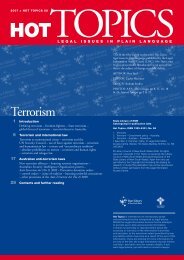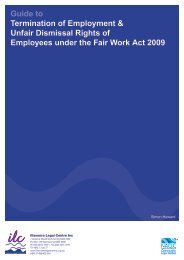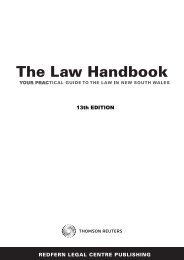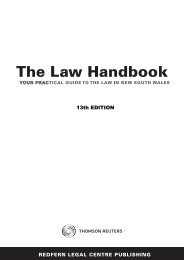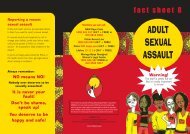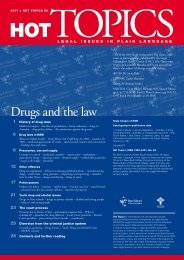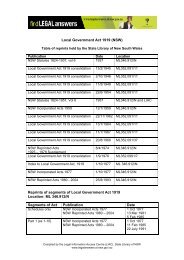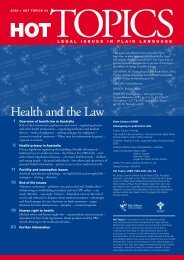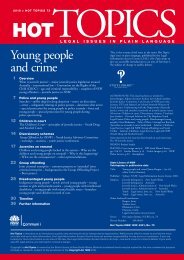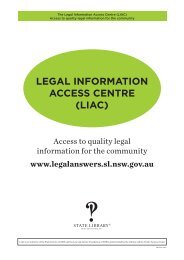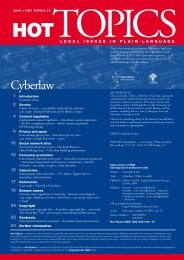Shelter - Hot Topics 57 - Legal Information Access Centre - NSW ...
Shelter - Hot Topics 57 - Legal Information Access Centre - NSW ...
Shelter - Hot Topics 57 - Legal Information Access Centre - NSW ...
- No tags were found...
You also want an ePaper? Increase the reach of your titles
YUMPU automatically turns print PDFs into web optimized ePapers that Google loves.
By this time, vagrancy and drunkenness offences, inparticular, had begun to be criticised for punishingpersons who really needed social support and medicaltreatment – criticisms highlighted by the Commission ofInquiry into Poverty 27 ). In <strong>NSW</strong>, vagrancy, drunkennessand a number of related offences were abolished with thepassage of the Summary Offences (Repeal) Act 1979.Nonetheless, homeless persons remain highly visibleto police and are particularly likely to be the subjectof criminal proceedings. The <strong>NSW</strong> Law and JusticeFoundation’s ‘<strong>Legal</strong> Needs Survey 2003’ found thathomeless persons were more than twice as likely aspersons with housing to have experienced a criminal lawproblem. 28 The offence of vagrancy remains repealed,but some related offences, such as offensive conductand offensive language, have been revived under theSummary Offences Act 1988. In 1998, ahead of theSydney Olympics, amendments to the Summary OffencesAct 1988 gave police the power to ‘move on’ persons(section 28F). Drunkenness remains decriminalised, butthe Intoxicated Persons Act 1979, which was intended tobe legislation on a ‘social welfare’ rather than ‘criminal’model, is nonetheless coercive and brings homelesspersons into contact with the criminal justice system.Under the Intoxicated Persons Act 1979, police still havepowers to ‘detain’ persons who are found ‘intoxicated in apublic place… behaving in a disorderly manner’ (section5(1)), and detained persons are held in ‘proclaimedplaces’, including certain welfare services – and policestations.Additionally, some varieties of ‘public’ space are subjectto specific legal regimes that can disproportionatelyaffect homeless persons. The spaces of public transportare governed by the Rail Safety Act 2002 and the RailSafety (General) Regulation 2003, which contains 27separate offences relating to conduct, including:> offensive behaviour and language and spitting (clause13);> wearing soiled clothing (clause 14);> smoking (clause 15);> eating and drinking (clause 16);> consuming alcohol (clause 17);> being intoxicated (clause 18); and> ‘unauthorised commercial activities’, including begging(clause 19);not to mention offences relating to tickets.Offences and fines relating to car parking, registrationand licensing are significant issues for homeless peoplewho rely on a car for shelter.Another issue is that increasingly large parts of whatlooks like the public spaces of towns and cities areactually ‘mass private property’. 29 These spaces, suchas shopping malls and car parks, are generally open toeveryone, but are heavily regulated aesthetically as towhat sorts of persons and activities fit in – and thosewho do not fit in are liable to be refused entry or evictedthrough selective enforcement of the owner’s right topossession.SquaTTiNgSquatting is the occupation of property without a legalright to do so. Buildings that are regularly occupied bysquatters often come to be known as ‘squats.’ In someinstances, squats are more or less organised, with thesquatters co-operating to provide some level of amenityand comfort in the building – and sometimes to makea political point about housing. More often, though,squats are uncomfortable, insecure and even dangerousplaces.Being without a legal right to occupy premises, squattersare trespassers, and can be evicted by a person entitled topossession of the property. The police also have powersunder the provisions of the Inclosed Lands Protection Act1901 (<strong>NSW</strong>) to evict and charge trespassers who refuseto leave premises.SuppOrTed accOmmOdaTiONaSSiSTaNce prOgram (Saap)The Supported Accommodation Assistance Program(SAAP) funds non-government organisations to provideaccommodation and other support to homeless personsand persons at risk of becoming homeless. SAAP isfunded by Commonwealth and States governmentsunder the provisions of the Supported AccommodationAssistance Program Act 1985 (Cth).In terms of housing, the legal relationship betweenSAAP services and their clients is usually that of landlordand lodger. Depending on the circumstances, however,a resident of a SAAP service may be a tenant under theResidential Tenancies Act 1987: see, for example, Ellis vCity Women’s Hostel 30 .27. Homeless people and the law: report of the Commission of Inquiry into Poverty, R Sackville, AGPS, Canberra, 1976.28. No home, no justice: the legal needs of homeless people in <strong>NSW</strong>, Law and Justice Foundation of <strong>NSW</strong>, Sydney, 2005; http://www.lawfoundation.net.au/report/homeless.29. ‘Modern private security: its growth and implications’, C Shearing & P Stenning, in Crime and justice: an annual review of research, vol 3, MTonry & N Morris (eds) University of Chicago Press, 1981.30. (1997) RTT 97/022789 ; available at www.austlii.edu.au/au/cases/nsw/<strong>NSW</strong>RT/1997/258.html.22HOT TOPICS <strong>57</strong> > <strong>Shelter</strong>


